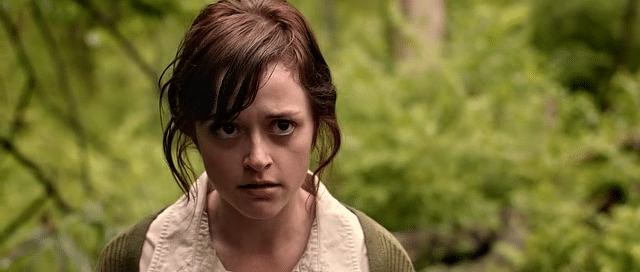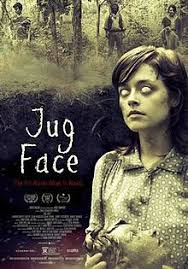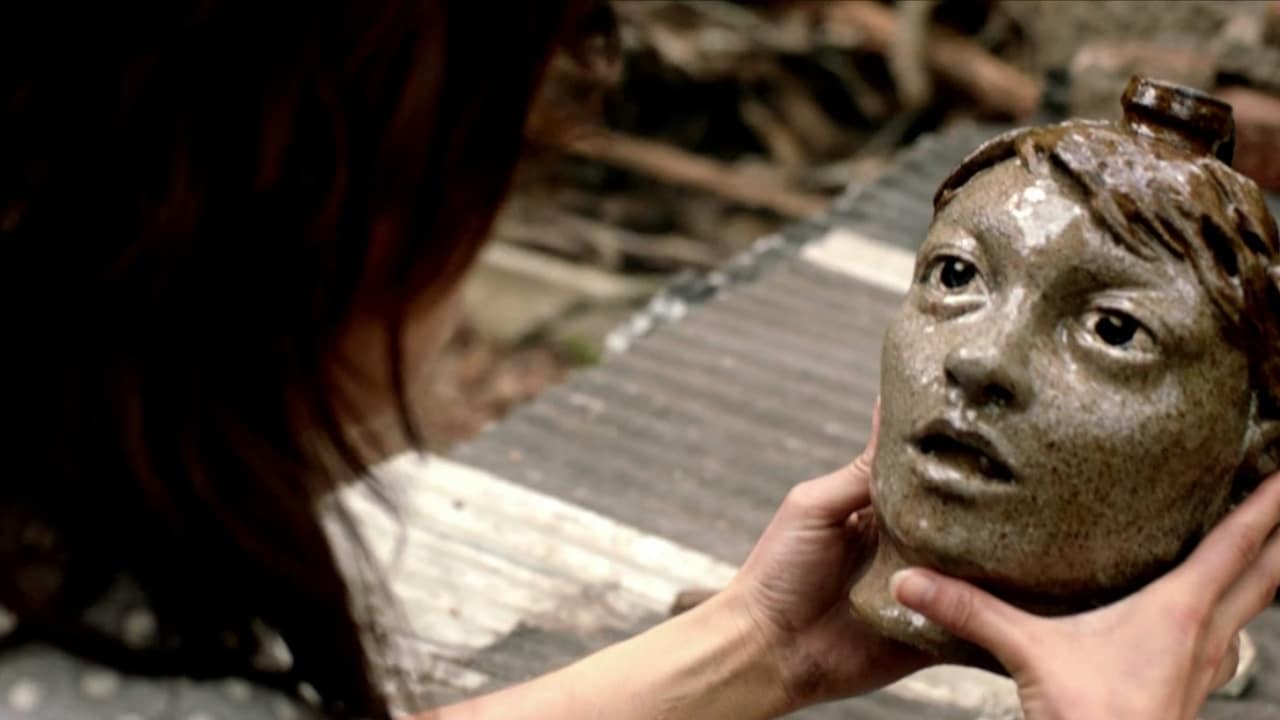
By Keri O’Shea
The idea of destiny – the inescapability of some event or course of action, come what may – is an ambiguous one at best, and on one distinct level, it is downright terrifying. If any way in which you try to exercise your personal volition is pointless, or worse still, messes with the order of things to the detriment of those around you, then perhaps you are damned to follow a path, rather than destined, and the very idea of agency itself becomes fraught with risk. When you meld this idea with a powerful tale of an isolated community, intrigue and the supernatural then you have all the elements in place for a compelling piece of storytelling – and so, we have Jug Face, a heat-hazed horror which draws you in from the get-go; the film’s plot is unafraid to be as ambiguous as the very ideas at its core and, more so, it is unafraid to be delightfully downbeat.
Through the simple, though ingenious animated opening credits we are introduced to a community which has long lived in the boonies of America’s Deep South (the film was actually shot in and around Tennessee). We garner hints of some arcane, genuinely Lovecraftian presence which has long made certain demands of the people living in its midst, as we see that the original settlers – originally pious and worshipful – have had their faith rocked by the arrival of smallpox, and the inability of Christianity to do a thing about it. A desperate citizen, his daughter now dying of the illness, walks into the woods to pray for guidance, kneeling at the side of a naturally-occurring pit in the earth; he feels driven to cast something in clay, and creates a face jug (an actual tradition in America’s Southern states) which bears a striking resemblance to the local minister. Desperate times call for desperate measures; the townspeople, believing they have received a sign, ritually kill the minister, allowing his blood to pour into the pit. Once they have done so, the smallpox clears up. Thus is signed a blood pact: the pit will protect them always – that is, just so long as they bring it the victim it chooses when it chooses. It does this by inspiring a seer amongst the community to cast a face jug of the intended sacrifice. How’s that for a creative premise?

This brings us right up to the present day and we meet our main character, Ada (Lauren Ashley Carter, also of The Woman). Ada lives under the domineering presence of her mother Loriss (the brilliant, menacing Sean Young) and father Sustin (Larry Fessenden) but even with them keeping an eye on her to stop her ‘transgressing’ before she can be joined to the local boy of their choosing, Ada has been fooling around – and this could land her in enough trouble, especially considering the boy in question, but it gets far worse when Ada visits her friend and the current seer Dawai (Sean Bridgers) and finds a new face jug bearing her image, which he made in a recent trance, although he hasn’t yet seen it himself. Does she feel like meekly submitting to her fate? Nope, so, panicked, she takes the jug, burying it in the woods. Has she been chosen because she has transgressed the codes of the community, or was her number going to be up anyway? This isn’t made clear – you may form your own opinions on that score – but what is certain is that she does not want to die, and decides to fight for her life. Her decision to rebel against a centuries-old system has bitter consequences.
Because let’s get one thing clear here: what this isn’t is a film about some deluded bunch of hillbillies living in the back of beyond and nursing deranged beliefs about some entity out in them there woods. Jug Face isn’t playing around and it doesn’t utilise any of the expected cop-outs; in some respects like Stuart Gordon’s Dagon in thematics, the supernatural being which is to be found in the pit is very, very real, and there are consequences in trying to thwart it. You might not see it (creature FX were mistakenly made ahead of the shoot but aren’t really visible in the movie, and the film is stronger for it) but it is there, and it knows. As for the community which has always kept its pact with this presence, they do live under brutal rules and their ways are strange, but it’s refreshing when a filmmaker can depict such often stereotyped people in a humane way, without feeling the need to make us think that they drink Coors and shop at Gap in order to get us to relate. They’re different, they’re inflexible and they’re frequently cruel, but writer/director Chad Crawford Kinkle has tempered their brutality with sympathy. Yes, the rules of their existence are harsh, but they’re necessary. The consequences to doing or being otherwise are just too great to be risked. I also liked the notion of the Something existing in a place as ostensibly mundane as a pit in the ground – although that idea, like the face jug motif itself, has its roots in history; many native peoples have worshipped caves, pools or other natural features as in some way divine, so it’s an idea ripe still ripe for use in a horror setting.
Ada, however, does risk those consequences: in keeping with the rest of the film’s cleverly-crafted characters, her decision to fight for her life is both eminently understandable and, as the film progresses and the pit fights for what it’s due, utterly mercenary. She’s no straightforward victim whatsoever, although at first it seems as though she’s lining up to be just that. I found myself moving through lots of different shades of feeling towards her character, vacillating between consideration and exasperation. Carter plays her role well, a doe-eyed innocent one minute, a shrewd manipulator the next. But ultimately, no matter how your empathy waxes and wanes, you of course understand why she wants to resist the pit’s claim on her. I guess what Jug Face does so very well is to show how human behaviour can be understandable and deeply flawed all at once, utilising its superb cast to really drive that lesson home. Sean Young is captivating as the matriarch who embodies the tough living and strict codes which hold her community together, and Fessenden, a gifted character actor, is a man who can add a few touches of humour to his hard-line presence on-screen. However, for me the strongest member of the cast has to be Bridgers as Dawai. If you were repulsed by his character in The Woman, then his role here couldn’t be more different. Only clever writing and acting could ever prevent a mentally-challenged, rural Southern character from becoming an insult; Tony Elwood managed to avert this in his criminally-underrated movie Cold Storage in 2009 with the character of Clive, and Chad Crawford Kinkle has definitely avoided any insult here. I was surprised by just how many moments of often much-needed levity Bridgers was able to achieve – maybe the film needs this pressure valve. In any case, Dawai is charming, likeable and very, very real.
Throughout, this is a gripping piece of story-telling, and the ending of this story is, as I reflect on it now, absolutely note-perfect, stopping the audience from getting into a cosy comfort zone to the last. When you consider that a film of this calibre was made on a shoestring budget in seventeen days, you could be forgiven for feeling that Hollywood today is a spent force when it comes to all the important things like vision, honesty and integrity. Jug Face plays around with some elements from familiar horror tales but updates them; it takes some real-life phenomena but creates with them. Look out for this title and look out for this director. Incredibly, this is Kinkle’s first feature film, and it promises great things yet to come.
